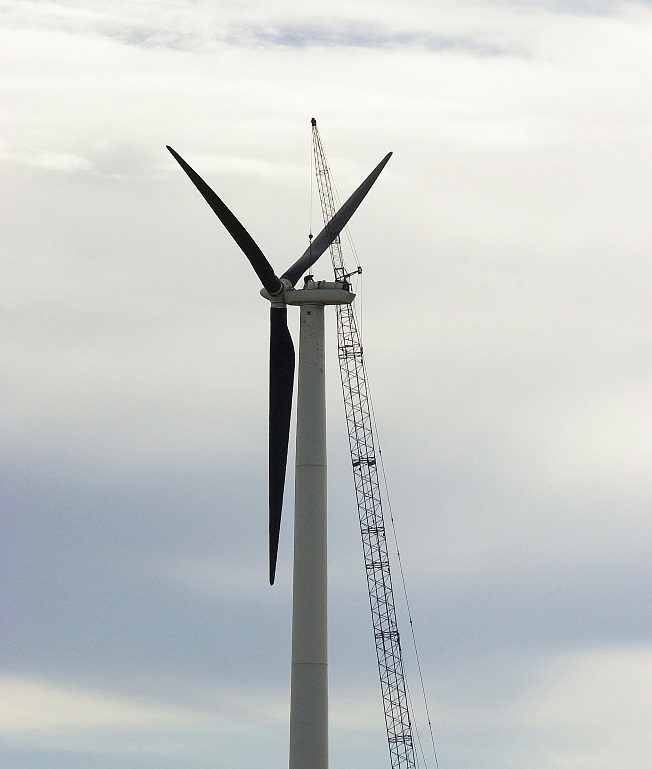Clean Energy First Act rises again, slightly revised

(UPDATED at 5:58 p.m. with division action)
In 2019, the House passed the “Clean Energy First Act,” a bill that forged a path toward the state using only carbon-free energy sources by 2050. The central premise of the bill: Whenever a utility proposes to replace or build a new power generation source, renewable energy sources like solar and wind should be given top priority.
Although it was included in the omnibus jobs and economic development, energy and climate, and telecommunications policy and finance bill that passed the House, almost all of its energy and climate initiatives were eliminated by a conference committee.
But it’s back – in slightly revised form.
HF1405 is sponsored by Rep. Zack Stephenson (DFL-Coon Rapids) and it carries many of the same provisions as the 2019 bill. It would provide directives to the Public Utilities Commission on a range of issues related to the transition from fossil fuels to renewable energy.
After hearing testimony from representatives of utilities, environmental advocacy organizations, and business and industry groups, the House Energy and Climate Finance and Policy Division adopted five amendments to the bill and half of another Tuesday afternoon, rejecting nine other amendments.
HF1405 was then approved, as amended, by an 8-6 party-line vote and returned to the House Ways and Means Committee, with the recommendation that it be referred to the House Jobs and Economic Development Finance Division.
The bill’s companion, SF1456, is sponsored by Sen. David Senjem (R-Rochester) and awaits action by the Senate Finance Committee. Some testifiers at the House hearing said there are key differences between the bills.
Among its main provisions, HF1405 would declare that it is state policy to meet electricity demand with a combination of clean energy resources. It would also require utilities to:
- develop an integrated resource plan on meeting demand with clean energy and carbon-free resources;
- analyze operating coal-fired generating units on a seasonal basis;
- maximize employment opportunities for local workers and consider local job impacts when selecting energy resources; and
- identify plans to replace or upgrade transmission resources that will end within 15 years.
The bill would require that the Public Utilities Commission:
- establish a range of environmental costs associated with each method of electricity generation;
- not approve a nonrenewable energy facility in a resource plan unless a renewable energy source is not affordable or reliable; and
- condition its issuance of a site permit on employees being paid, at minimum, the prevailing wage rate.
It would also direct the Department of Commerce to develop programs to mitigate the local impacts of power plants being retired, and to request that the Midcontinent Independent Systems Operator conduct an engineering study on the costs and impact on reliability of upgrading the regional electric transmission network to support the increased use of carbon-free resources.
And the bill would require new wind turbines be equipped with lighting systems that mitigate duration and intensity.
The adopted amendments would require utilities to provide customers information about:
- current rate schedules on the utility’s website;
- financial incentives for energy efficiency and the use of renewable energy sources; and
- generation sources and environmental impacts.
Other amendments that were adopted would prioritize the hiring of workers from communities with retiring power plants and clarify language about nuclear facilities currently in use.
Stephenson emphasized that “the price of wind and solar are low and dropping. … The cost of those resources is dropping 1% a month. … This bill is designed to smooth the transition between fossil fuels and renewable energy use in our state.”
Kevin Pranis, marketing manager for Laborers’ International Union of North America, said, “We’ve heard climate change referred to as a house that’s on fire. If that’s the case, then Clean Energy First is the bucket brigade, a plan to all pull together to make clean energy progress as quickly as possible, one bucket at a time. … We can’t afford to wait for that big shiny fire engine to start to put out the fire.”
Related Articles
Search Session Daily
Advanced Search OptionsPriority Dailies
Ways and Means Committee OKs proposed $512 million supplemental budget on party-line vote
By Mike Cook Meeting more needs or fiscal irresponsibility is one way to sum up the differences among the two parties on a supplemental spending package a year after a $72 billion state budg...
Meeting more needs or fiscal irresponsibility is one way to sum up the differences among the two parties on a supplemental spending package a year after a $72 billion state budg...
Minnesota’s projected budget surplus balloons to $3.7 billion, but fiscal pressure still looms
By Rob Hubbard Just as Minnesota has experienced a warmer winter than usual, so has the state’s budget outlook warmed over the past few months.
On Thursday, Minnesota Management and Budget...
Just as Minnesota has experienced a warmer winter than usual, so has the state’s budget outlook warmed over the past few months.
On Thursday, Minnesota Management and Budget...